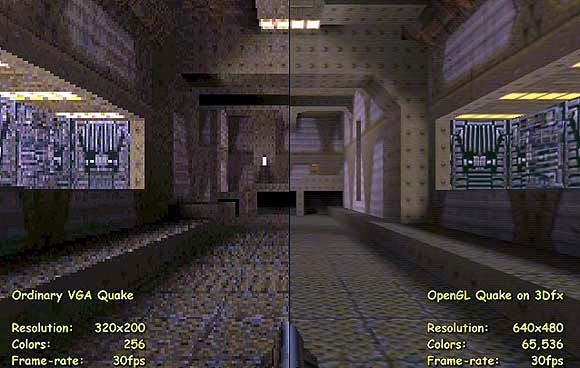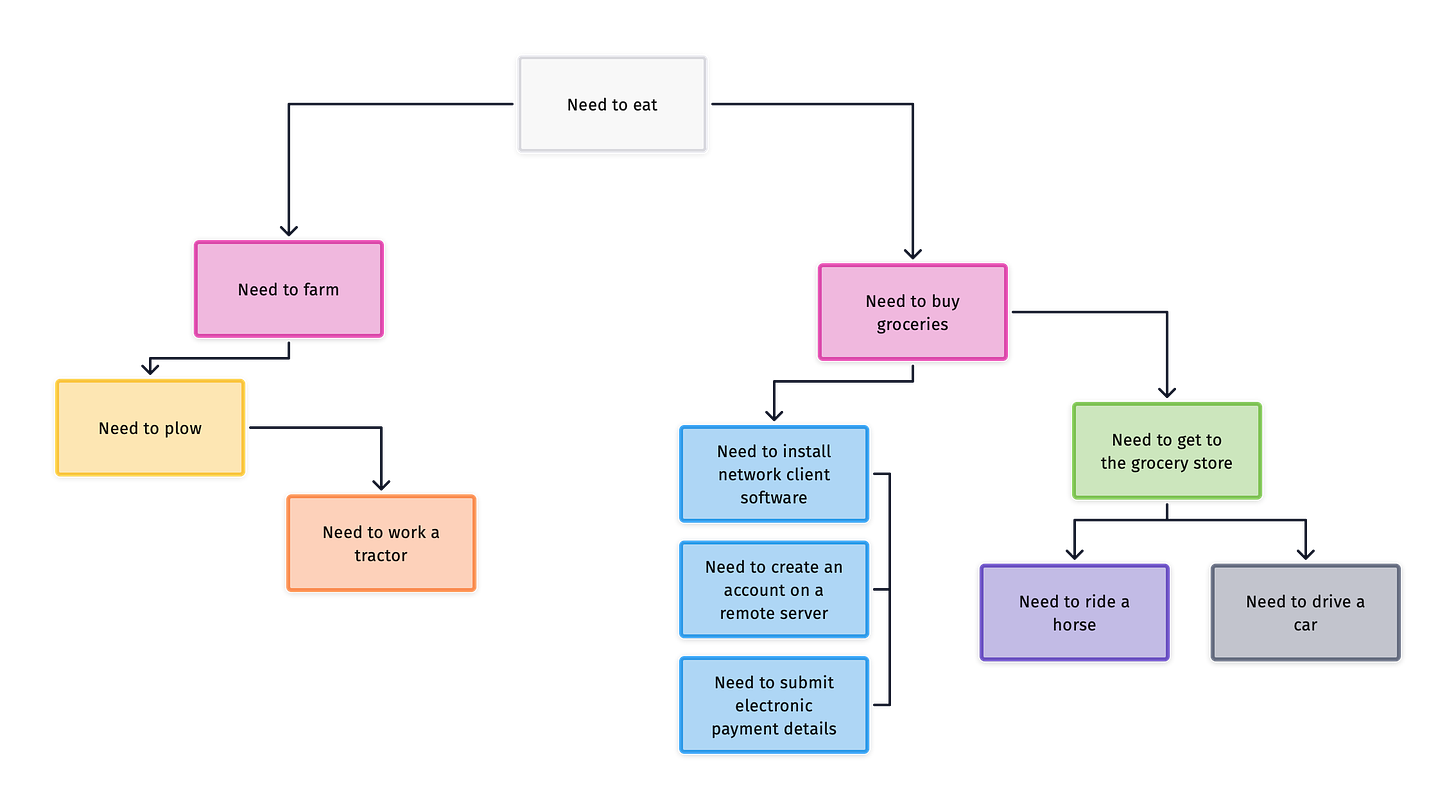can opener problem (noun)
The problem you face when trying to explain the operation of a can opener to someone who has never seen or heard of a can. More generally, the problem of explaining a specialized solution to an audience for whom the corresponding problem is completely alien.
Alice: I was trying to explain ZK rollups to Bob, but he barely even understands what a blockchain is.
Mallory: Yeah, can opener problem fr.
Imagine the year is 1997, and you’ve just sprung for a moderately nice GPU to drop into your Pentium system. You’re really into Quake, and after seeing some mind-blowing screenshots of GLQuake, you saved enough money to buy a Diamond Stealth II PCI from Micro Center. Ok yeah, it’s not the best, but it’s the best you could afford on your pizza delivery budget.

As you lift the GPU carefully out of the box and turn it over in your hands, you fantasize about how you’ll be the envy of this weekend’s big LAN party.
Suddenly, a blinding flash of light overwhelms your vision. There’s an instant rush of silence as all the sounds of your urban apartment building immediately cease. When your eyes start to recover a moment later, you find yourself standing outside in a pasture, facing a big red barn with a little house next to it. There’s a wagon out front with a pair of horses hitched to it, and a family of five is making their way out of the wagon when they spot you standing there in the sun holding your new GPU in your hands.

Let’s fast-forward our story one week, during which time you’ve been staying on the farm with the very nice family that runs it. It turns out you were mysteriously transported exactly 200 years into the past, to 1797. Obviously, you have a lot of questions about how and why that happened, but the farmers really only have one question for the oddly dressed stranger who knocked on their door in a state of confusion: what is the point of the device you were holding in your hands when you arrived, the one with the words “Diamond Stealth II PCI” printed on a sticker on the side?
Wow, this is a tough one.
You try unpacking for them the concept of “computer games,” but their frame of reference for games is limited to chess, checkers, stickball, cornhole, and similar contests.
“The computer” as a concept also doesn’t really help much, because if you try to describe it as a calculating machine, that doesn’t even get them anywhere near the concept of Pong, much less “GLQuake.”
Besides, you don’t just want them to understand that this is a device that does math or even vector math. When they ask what the point of it is — why you have it and what it’s going to do for you — the goal is to give them some kind of understanding of the experience you were expecting to have when you slotted this graphics card into your PC.
You were going to sit down in front of a box with a glass on the front, look into a 2D projection of a 3D fantasy world, and then move around in that fake world and carve up angry demons with a nail gun or a chainsaw or a rocket launcher.
Now, these farmers are really smart. They’re all really good at chess and mathematics and have memorized huge swaths of the Bible and various poems. After just a week with these people, you’re pretty sure you’re the lowest IQ person under their roof.
Nonetheless, it’s difficult for you to muster a satisfactory explanation with words or even pencil drawings that communicates what you were planning to do with this GPU. There are just so many missing points of reference because you have to describe a whole other world to them in order to place this device in context.
At least they have you there to attempt to explain it to them, though. It could be worse — whatever time-traveling force could have just transported the GPU alone back in time, without you to explain it.
If the farmers had come across this GPU laying in their field, it seems pretty clear that they would never, ever be able to reason backward from the design of the device into any aspect of its nature or function.
The farmers would recognize that this object labeled “Diamond Stealth II PCI” is a manufactured device of some sort. They would grasp that it has a purpose and that there’s some context, somewhere, in which this device makes sense. But they wouldn’t be able to go any further than, “it’s man-made, it and serves some strange purpose that we’ll never comprehend.”
A GPU is a really complex, specialized piece of technology, so as an example of “tech that farmers in 1797 can’t understand” it’s pretty extreme. We can substitute a simpler device and the story will still largely hold up. What if in the two scenarios above — the one where you go back in time with a piece of tech, and the one where the tech goes back in time by itself without you there to explain it — we replaced the GPU with a simple can opener?
The can opener is a useful meta-problem

In my personal life, I often find myself trying to explain some bit of esoteric tech to friends or family, and in recent years when I’m in these situations I’ll often introduce my audience to the concept of “the can opener problem.”
A can opener of the type pictured above (called a “bunker can opener”) is a simple device. Yet if you had never in your life seen a can, it would be hard for you to visualize how this kinda weird, specialized little gadget works. You’d certainly never figure out what it’s for entirely on your own, and even with a seasoned can opener user to talk you through it, you’d probably still have some trouble really visualizing how it works.
In my experience, the can opener problem is a meta-problem that unlocks a specific, often useful intuition in the hearer. It’s basically the GPU problem above but packaged up for non-nerds who don’t know anything about GPUs or 3D games.
The intuition I’m trying to unlock in my audience when I talk about can openers is something along the lines of, there are certain kinds of people who live in a different world where they have this peculiar problem, and this weird technology being described fits with those people’s specialized problem. In other words, this isn’t some new solution to a normal or familiar problem, but rather it’s a new solution to a new and alien problem.
When people realize that the thing I’m describing is an alien solution to an equally alien problem, they stop trying to intuit what the tech does and then they engage their imagination in a way that they hadn’t, before.
I find myself using the can opener often when the topic of cryptocurrency comes up with normies. I’ll try my best to explain whatever crypto thing — public/private key pairs, NFTs, proof-of-work, etc. — and at some point, when I can see they’ve hit a wall, I’ll bust out the can opener.
I’ll say something like, “Imagine you’ve never seen a can and someone shows you a can opener. It’s a really simple device, but you’d never be able to figure out what it’s for without someone either showing you a can or spending a lot of time explaining how it works. This thing I’m explaining to you is like that — you have to understand the weird problem it solves before you understand the thing.”
What I’m saying to people when I use the can opener on them is, “you may feel stupid for not grasping this, but you’re not. This is actually a simple device, but the world just hasn’t yet presented you with the specific problem that this device solves.”
Note: I didn’t invent this particular use of the can opener as a metaphor, but I have no idea where I picked it up or I’d give credit to a source. If anyone has heard this “can opener” thing before and thinks they know where it came from, please get in touch with me.
Web3 is a can opener problem factory
Both the can opener and the GPU are actually easier to reason about than many crypto concepts because they can be placed in the context of larger problems that meet basic human needs, and that even the most technologically naive audience can understand.
In the case of the can opener, it’s a device for accessing food that’s stored in a particular way. Any human can grasp this because we all need to eat, and we’ve been getting food from containers for millennia, now. The GPU example is a bit trickier, but it’s still about entertainment, and everyone understands entertainment. Insofar as the Diamond Stealth II PCI is a device that helped me and my friends entertain ourselves by escaping into a fantasy world, there’s a core value proposition there that any human can connect with, regardless of whether they’ll ever get the details.
Cryptocurrency, though, has a well-established problem in this regard: most people don’t have an immediate human need for transaction privacy, inflation hedging, trustless commerce with anons, or any of the other applications that crypto is often advertised as suitable for. So there’s really no way to situate the use case for Bitcoin, the paradigmatic cryptocurrency, in a general problem space that the average person in the developed world is constantly, actively dealing with in their day-to-day life.
In even worse shape here is “web3,” which not only presents itself to outsiders as an impenetrable mess of can opener-like solutions to an alternate universe of alien problems, but is in practice essentially a toolkit for creating endless new problem/solution pairs at even further heights of distant abstraction. Some of these web3 solutions can be slotted into very general categories like “entertainment” or “art collecting,” but many of them are so far up the recursive stack of “web3 solution to web3 problem that’s created by this other web3 situation that rests on another web3 concept…” that it often feels they’ll never connect to anything anyone normal could possibly care about.
Now, this “can opener factory” situation isn’t the end of the world. Even the aforementioned recursive stack of web3 problem/solution pairs doesn’t necessarily mean doom. In fact, the above fairly described “the microcomputer” and later “the internet” for a very long time. So let’s take a step back and look at how this has played out, recently:
All humans need to eat, so everyone gets that. But in order to eat, maybe your great-grandparents needed to farm. Which meant they needed to plow, which might further have implied a need to operate a tractor.
But in 2022, a meaningful number of grandparents who need to eat have willingly joined the ranks of people who also need to perform a set of steps that until relatively recently were very high up the tech abstraction ladder. I’m talking about the blue squares in the above diagram, where you install some client software, connect to a server, create an account, enter electronic payment details, and so on. Very few people were using this corner of the tech solution space when I was in high school in the early 90s, and certainly none of the humans who were then doing those steps were doing them in the name of needing to eat. Online grocery purchase and delivery wouldn’t be a thing for some two more decades.
But here in 2022, normies of all ages and types are installing software, connecting to servers, creating and managing accounts on multiuser systems, and just generally slinging a previous generation’s “can openers” around like Hong Kong action movie stars in a ten-minute fight scene.
For web3’s endless stream of can openers to get to the level of ubiquity that a cluster of formerly obscure client/server can openers have gotten to, crypto builders and investors will need to explore more branches off of the “trustless commerce” concept tree than just “transaction privacy” and the like. Specifically, there’s another branch of alignment problems that crypto can help with and that normal people are able to understand that they do in fact face on a regular basis.
Whether they know it or not, everyone has faced the principal-agent problem many times in their life. Smart contracts can play a role in opening this particular can.
Most people know the media is a disaster, and that money is somehow implicated. Web3 offers a toolkit for addressing this tangle of perverse incentives through the power of alignment and transparency.
Here in America, we famously do not like one another, and this leads to nothing getting done. The network state is essentially an entire family of concepts centered around using web3’s alignment tools to create political formations that have recovered the power to act in the real world.
Remittances are actually a real-life, first-world use case for crypto, but the benefits are third-world so it flies under the radar.
I could go on for a few more, but part of the point of this newsletter is to fill out a list like this. And, in fact, the real point of my writing this post is so I can reference the “can opener problem” concept in future posts when I’m trying to contextualize some new crypto-based solution for a problem that few people have now but many may have in the future.
Win conditions
The way that you know a specialized piece of technology is so ubiquitous that it has graduated from “can opener” status, is when you can reliably use that piece of technology to explain some other, newer can opener-type tech to normies.
In other words, the day I find myself telling some rando, “well, this new thing is sort of like a blockchain,” and they go “ah, yes, now see,” then “blockchain” is at that point such a part of most people’s mental furniture that they can hang entirely new concepts on it.
When I was an undergrad, I’m not sure I’d have ever imagined a day when I could reliably expect to be able to explain something to a random person on the street by telling them, “this is like when you make an account on a server in order to buy groceries or send messages,” but that day is definitely here. The majority of people across the entire planet now have a formidable collection of multi-user computing abstractions at their command, and they can use those abstractions as reference points for even newer, more complex abstractions.
It’s pretty wild, when you think about it, that so many elaborate computing concepts that were quite boutique just 25 years ago are now pretty much “ready-to-hand” (in Heidegger’s lingo) for a few billion smartphone users.
So the win condition for web3 is, “it’s like a public/private key pair,” or “it’s like a smart contract,” and so on. When we all find ourselves explaining new concepts with reference to today’s crypto can openers, we’ve made it.







But beware the macchine inutili fallacy, which is the tendency to assume that a complex artifact must be in the nature of a can opener and not a useless machine.
What a brilliant piece!!
Nothing impressed me like that for a long time!
Will forward to normies that ask 'what is that bitcoin thing?' and then fall asleep on 30th second of my explanation